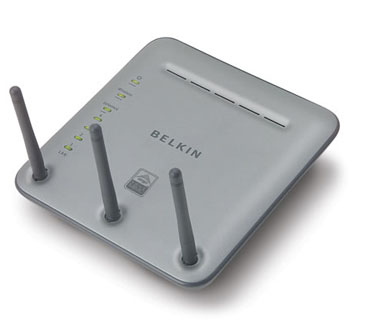
This Belkin router provides wireless and Ethernet connections, while also acting as a firewall
Ethernet and wireless networks each have advantages and disadvantages; depending on your needs, one may serve you better than the other. Wired networks provide users with plenty of security and the ability to move lots of data very quickly. Wired networks are typically faster than wireless networks, and they can be very affordable. However, the cost of Ethernet cable can add up -- the more computers on your network and the farther apart they are, the more expensive your network will be. In addition, unless you're building a new house and installing Ethernet cable in the walls, you'll be able to see the cables running from place to place around your home, and wires can greatly limit your mobility. A laptop owner, for example, won't be able to move around easily if his computer is tethered to the wall.
There are three basic systems people use to set up wired networks. An Ethernet system uses either a twisted copper-pair or coaxial-based transport system. The most commonly used cable for Ethernet is a category 5 unshielded twisted pair (UTP) cable -- it's useful for businesses who want to connect several devices together, such as computers and printers, but it's bulky and expensive, making it less practical for home use. A phone line, on the other hand, simply uses existing phone wiring found in most homes, and can provide fast services such as DSL. Finally, broadband systems provide cable Internet and use the same type of coaxial cable that gives us cable television.
If you plan to connect only two computers, all you'll need is a network interface card (NIC) in each computer and a cable to run between them. If you want to connect several computers or other devices, you'll need an additional piece of equipment: an Ethernet router. You'll also need a cable to connect each computer or device to the router.
Once you have all of your equipment, all you need to do is install it and configure your computers so they can talk to one another. Exactly what you need to do depends on the type of network and your existing hardware. For example, if your computers came with network cards already installed, all you'll need to do is buy a router and cables and configure your computers to use them. Regardless of which type you select, the routers, adapters and other hardware you buy should come with complete setup instructions.
The steps you'll need to take to configure your computers will also vary based on your hardware and your operating system. User manuals usually provide the necessary information, and Web sites dedicated to specific operating systems often have helpful tips on getting several different computers to talk to each other.
Most people who have a basic familiarity with computers can set up a network without much help. But the idea of installing cards and making connections makes some people nervous. Many Internet service providers (ISPs) offer home networking packages. For a monthly fee (and sometimes an initial setup cost), the ISP will provide you with the hardware and support you need to build and maintain your network.


